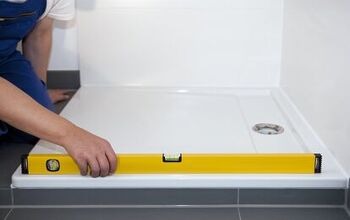8 Tips To Downsize From A House To An Apartment

The thought of moving out of a big house into a smaller apartment can be daunting. However, it’s a great change that pays off in both living expenses and simplicity. We understand it seems challenging, so that’s why we put together 8 tips to help you downsize from a house to an apartment.
Declutter your house before you downsize to an apartment and sell or donate old furniture you don’t need. Start packing 4-6 weeks before moving and gradually clean your house throughout the process, so it’s clean for the buyer. Hire a professional service if you don’t have extra help or if you’re on a limited schedule.
Make sure to refer to your apartment’s floorplan when you downsize and plan your furniture layout. Follow along as we highlight the best tips to downsize from a house to an apartment without changing your lifestyle.
How To Transition From A House To An Apartment
1. Declutter Your House
Let’s face it: your future apartment won’t likely have as much space as your current house. There may not be enough space for all the clutter in your house, and most of the clutter isn’t even necessary. Decluttering not only lightens your load, but also streamlines your life.
There’s a good chance that many of the rooms in your house have items that you can pitch, donate, or sell. Check your drawers, closets, and storage rooms for items that you don’t need to bring to your new apartment. Old books, art, magazines, newspapers, paid bills, and knick-knacks that you don’t use aren’t worth taking with you.
This is a great chance to make some extra cash as well. You can easily sell old furniture, instruments, clothes, and collectibles online. Otherwise, you can simply host a traditional garage sale to unload anything you don’t want to throw away or donate.
2. Start Packing Early
Moving can be overwhelming, especially when you downsize from a house to an apartment. You can make the process easier if you start packing early. Start packing at least 4 weeks before you move to avoid stress and problems that may pop up unexpectedly.
Some people even start packing 6-8 weeks before moving, and that’s a great idea if you have a big house. Pack seasonal clothes and items you don’t regularly use first to get them out of the way, and then move at your own pace. Save pet items, food, and toiletries for last, so you don’t have to go without them for too long.
3. Simplify Your Furniture
Does your house have some furniture that won't fit into your new apartment’s floorplan? If so, there’s no reason to panic, as you may not need to get rid of it. Instead, you can get creative and figure out how to reconfigure the furniture to fit the floorplan.
It may be worth donating or selling some furniture, but there’s no reason to get rid of it all. Measure your tables, chairs, couches, and dressers and compare them to your future apartment’s dimensions. You would be shocked at how much even simply angling a table or dresser changes a room’s layout.
Some people even buy new furniture items that serve multiple purposes. For example, you can find coffee tables and ottomans that have drawers in them. This can save you from buying more furniture than you need, and it’s a great way to save space.
4. Research Your New Area
How far is your new apartment from your old house? There’s a good chance that you will find new stores, restaurants, bars, and even medical offices. It’s a great idea to use Google Maps or simply visit your new apartment a few times before moving there.
This will help you get an idea of what life will be like. You may have to run out to buy things you need during the move, such as nails and screws, so it helps to know where you’re going. It also helps to find online communities, such as Facebook groups and forums, to get tips about great stores in the area.
5. Start Cleaning
One of the worst parts of moving is having to clean your house throughout the chaos. It’s a necessary evil, as the next person to move into your home expects it to be clean. The best way to go about this is to slowly start cleaning room by room.
Granted, you won’t be able to finish cleaning until the house is empty. That’s when you can mop and vacuum and finish wiping down any dirty surfaces. Otherwise, you can hire a service to clean your house to make sure you get your deposit back or please the new buyer.
6. Delegate Responsibilities
There’s no reason to bear the weight of your move on your shoulders. Enlist the help of friends and family members to help with your move. You can each tackle different responsibilities and even pick rooms to focus on.
This speeds up the process and makes it easier to focus your attention on one thing at a time. It also helps you save money if you don’t plan to hire movers.
7. Consider Storage
By this point, you’ve likely already decluttered and gotten rid of some of your belongings. However, you may have furniture and collectibles of sentimental value that won’t fit in your apartment, but that you don't want to part with. That’s where storage comes into play, and it’s often necessary when you downsize to an apartment.
You can find affordable storage options in most cities and towns. It costs between $70 and $200 to rent the average storage unit, but big units cost more. Look for a climate-controlled storage unit if you plan to store delicate items, such as old art.
8. Hire Professionals
Hire professional movers if you live alone, have physical limitations, or simply don’t have time to focus on moving. Professionals have the skill, equipment, and experience to make your move as effortless as possible. Movers can pack, load, and transfer your belongings from your house to your apartment faster than you could in most cases.
Moving companies typically offer two price options: hourly rate and flat rate. Flat rates are great because you already know how much the move will cost. Hourly rates come in handy if you have a short, simple move. Granted, moving can take longer than expected, so you may wind up paying a lot with an hourly rate.
Make sure to ask about which services they offer, such as white glove service and furniture disposal. These options come at an extra cost, but they’re invaluable when downsizing from a house to an apartment. Keep in mind that it’s worth reaching out to multiple moving companies if you get a price quote that doesn’t sound right.
Summing It Up
Carefully consider your new apartment’s floorplan when you downsize from a house and declutter accordingly. Separate your belongings into several categories: keep, sell, donate, and throw away. Pack your belongings over a 4-6-week period before moving, and hire professionals if you could use some extra hands.
Related Guides:

Nick Durante is a professional writer with a primary focus on home improvement. When he is not writing about home improvement or taking on projects around the house, he likes to read and create art. He is always looking towards the newest trends in home improvement.
More by Nick Durante
















![10 Most Dangerous Neighborhoods in Baltimore [Updated]](https://cdn-fastly.upgradedhome.com/media/2023/07/31/9075655/10-most-dangerous-neighborhoods-in-baltimore-updated.jpg?size=350x220)










